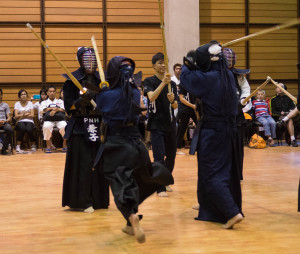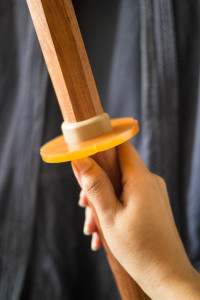Sempai Says, “Renshū This…” (TENOUCHI)

Me doing kirikaeshi during our kendo demo at CJCC for the 2015 Kizuna Festival.
My friends and family can attest that all you’ll ever hear from me since January of this year is nothing else but kendo.
Friend: “Hello! How was your weekend?”
Me: “Oh, I had such a great keiko with C– … I really need to work on my footwork though… .”
Friend 2: “Hey! How’s it going with your art? You doing anything new lately?”
Me: “Yeah, I’m now caught up in a different kind of art — a martial art! Kendo!”
Friend 3: “Is there anything that makes you happy?”
Me: “Um, kendo?“
That’s pretty much how my conversations with my friends pan out these days and there is no doubt in my mind how they’re weary of hearing about it. But they’ll just have to bear with it (if they’re really my friends). I take their crap, they can take my kendo.
So sometime last week I put together my notes about kendo and gave it the title, ‘Sempai Says, “Renshū This…”.’
I do have a sempai who told me to “renshū” a particular technique — he’s Japanese and struggles to explain stuff to me in English, so I’m receiving a lot of instructions in Japanese from him which amazingly I am able to understand (speaking in tongues much?) — and that’s where the inspiration of this title came from. My notes came from various sources in the web and from publications I bought off Amazon Kindle store, so allow me to put together what I have read (and/or learned) and hope you find wisdom from them too.

My locally-made bokuto. On my birthday, I start learning kata.
SEMPAI SAYS, “RENSHŪ THIS…”
TENOUCHI
- “Rigidity means a dead hand, and flexibility a living hand.” – Miyamoto Musashi
- “If too much strength is put in the right hand, the result is a decrease in the clarity of the cut, therefore one must strike with the left hand as the right hand is the accompanying hand it should be clasped tightly.” – Noma Hisashi
- “…Left arm doing 70% of the work, and right side 30% they should work in balance.” – Kendo Handbook for Beginners
- “Your left hand should be at navel height and turned in at an angle where you can easily support the weight of the shinai. Your right hand should be held at a relaxed angle without being forced, so that you can move the shinai easily. The grip from both hands comes from the little and ring fingers only.” – Chiba-sensei, rephrased by Geoff Salmon-sensei
- “…The idea is to push the left hand forward and pull the right hand back as you raise the shinai and then push the right hand forward and pull the left hand back on the strike. This happens as you are raising your arms from the shoulders so that you are not bringing the shinai straight back as if to scratch your nose.” – Geoff Salmon-sensei
- “Hidari de motsu, hidari de utsu” (You hold with your left, hit with your left) –– Kaku-sensei
- To grip the shinai:
- Extend the hand as if reaching out to give a handshake greeting.
- Position the hilt of the shinai on the inside portion of the heel of the hand.
- Grasp the shinai firmly with the little and ring fingers.
- Grip the shinai with the middle finger using moderate (not tight or loose) pressure.
- The index finger and thumb remains relaxed.
As of last week, my sempai (the very same one who makes me renshū stuff) remarked that my tenouchi is now better and offered me an hour of his time in the morning before kendo practice to teach me kata (forms). I am simply ecstatic! Not only am I touched that he has generously set some time aside to teach me kata one-on-one, but I am thrilled that the date of our first lesson falls on my birthday! So in an alternate universe where kendo dominates the world, this is an amazing birthday present!!
My first assignment: Learn Kihon Bokuto Waza.